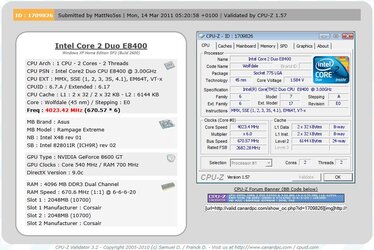- Joined
- Aug 30, 2002
- Location
- Southern USA
I'm trying to understand how the math works to arrive at the numbers below When dealing with a Q6600 quad core in Ram/FSB 1:1 ratio:
QDR = effective FSB speed
CPU FSB QDR Multi RAM Final MHZ
Q6600 266Mhz 1066QDR 9x 533Mhz 2400Mhz
Q6600 333Mhz 1333QDR 9x 667Mhz 3000Mhz
Q6600 400Mhz 1600QDR 8x 800Mhz 3200Mhz
Q6600 375Mhz 1500QDR 9x 750Mhz 3375Mhz
Q6600 450Mhz 1800QDR 8x 900Mhz 3600Mhz
Q6600 400Mhz 1600QDR 9x 800Mhz 3600Mhz
Since ram is double the data rate:
DDRMhz= 2 x RamMhz : FSBMhz x 4 =QDR) = 1:1
How does this equation change when a 1:2 ratio is taken into account?
If the math for 800Mhz ram in 1:1 ratio is: DDR800= 2 x 400Mhz : 400Mhz x 4 = 1600QDR) = 1:1 =3600Mhz
1. How does the math work out for DDR1600 ram in 1:1 ratio?
2. How does the math work for DDR1600 ram in 1:2 ratio?
QDR = effective FSB speed
CPU FSB QDR Multi RAM Final MHZ
Q6600 266Mhz 1066QDR 9x 533Mhz 2400Mhz
Q6600 333Mhz 1333QDR 9x 667Mhz 3000Mhz
Q6600 400Mhz 1600QDR 8x 800Mhz 3200Mhz
Q6600 375Mhz 1500QDR 9x 750Mhz 3375Mhz
Q6600 450Mhz 1800QDR 8x 900Mhz 3600Mhz
Q6600 400Mhz 1600QDR 9x 800Mhz 3600Mhz
Since ram is double the data rate:
DDRMhz= 2 x RamMhz : FSBMhz x 4 =QDR) = 1:1
How does this equation change when a 1:2 ratio is taken into account?
If the math for 800Mhz ram in 1:1 ratio is: DDR800= 2 x 400Mhz : 400Mhz x 4 = 1600QDR) = 1:1 =3600Mhz
1. How does the math work out for DDR1600 ram in 1:1 ratio?
2. How does the math work for DDR1600 ram in 1:2 ratio?
